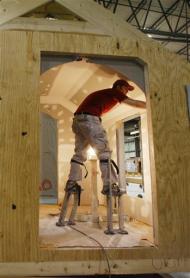WASHINGTON (AP) – The number of newly laid off workers filing for unemployment benefits rose last week to the highest level in nearly two months, providing more evidence that the weak economy is drying up jobs.The Labor Department said Thursday that applications for jobless benefits totaled 378,000 last week. That was an increase of 22,000 from the previous week and was a far bigger jump than had been expected.
The four-week average for new claims rose to 365,250, which was the highest level since a flood of claims caused by the 2005 Gulf Coast hurricanes.
The current economic slowdown, which many economists believe has already turned into a full-blown recession, is starting to show up in the labor market in terms of higher layoffs and weaker hiring numbers.

A worker prepares the walls for a new home at the Huntington Homes modular home factory in East Montpelier, Vt., Tuesday, March 11, 2008. The troubles in housing with falling sales and prices in many parts of the country have acted as a drag on the overall economy, contributing to a serious slowdown that many analysts are worried could push the country into a recession. (AP Photo/Toby Talbot)
The total number of payroll jobs fell by 63,000 in February, an even bigger decline that the drop of 22,000 jobs in January, which had been the first monthly decline since mid-2003.
“We have no doubt that the trend in claims is upwards and is approaching the levels seen in the earlier stage of the recession in 2001,” said Ian Shepherdson, chief U.S. economist at High Frequency Economics.
Part of the increase in benefit applications in recent weeks occurred because of a three-week strike at a major parts supplier to General Motors Corp., which has forced GM to close all or part of 28 plants, affecting more than 37,000 hourly workers.
The number of unemployed workers who are receiving benefits totaled 2.865 million, the largest amount since late August 2004.
Analysts said this increase was a worrisome sign that the economic weakness was boosting layoffs and making businesses cautious about hiring new workers.
“Hiring through 2007 was slower than the pace in 2006 and recent trends continue to suggest that businesses have pulled back even further on their hiring plans,” said Andrew Gledhill of Moody’s Economy.com.
The Federal Reserve this week cut a key interest rate by a sizable three-quarters of 1 percent, wrapping up the most aggressive two months of credit easing by the central bank in a quarter century.
The Fed has also greatly expanded its loans to cash-strapped banks and used a Depression-era process to supply money to Wall Street investment houses in an effort to keep a serious credit squeeze from pushing the country into a deep recession.
For the week ending March 8, 28 states and territories reported an increase in jobless claims and 25 reported declines. The states with the biggest increases were California, up by 3,755; Michigan, up by 2,236, and Indiana, with an increase of 2,158. The layoffs in Michigan and Indiana were attributed in part to higher layoffs in the auto industry.
The states with the biggest drop in claims two weeks ago were New York, down by 13,504, and Connecticut, which fell by 2,228.
Source: AP